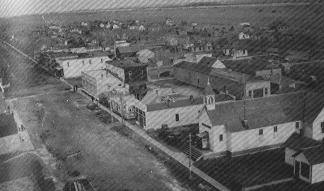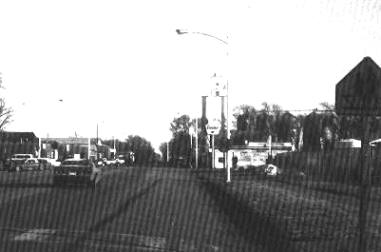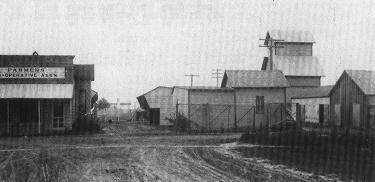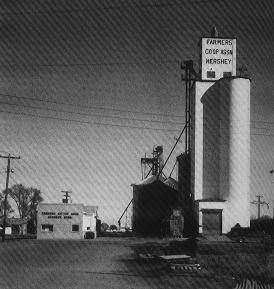
Hershey, located 13 miles west of North Platte, is in the heart of the valley between the North and South Platte Rivers, where farms are irrigated with water from the river. One of the first irrigation ditch company in Nebraska was organized in 1884 by the North Platte Land and Water Company. The head gate is about ten miles northwest of Hershey and the ditch reaches its highest point about four miles west. It waters the land south and east of town. The Birdwood Ditch, from northwest of Hershey, irrigates north of the river. The Farmers and Merchants Ditch, built in 1894, comes out of the North Platte a mile west of Hershey and is known as "the suburban ditch." It irrigates the land between the rivers to within a mile east of town. Pump irrigation is used during the dry season on land that is not conveniently located for the ditch water. Sugar beets, alfalfa, and almost all grains are raised. Sugar beet farming required hand labor which attracted many Mexican families to the area. The beets need thinning during the growing season and were harvested by hand. After they were loaded in wagons, they were piled at the beet dump east of town.
While the first Union Pacific Railroad tracks were laid in 1867, it wasn't until 1892 that the farmers and ranchers met to organize a town site company so they could have a post office and a railroad siding from which they could ship hay and potatoes. Annie Guthrie, widow of a railroad engineer, owned just over seven acres of land east of main street in 1892 that was platted for the town. Today Herchey village limits cover 305 acres. The town was named in honor of one of the owners of the Paxton & Hershey Land and Cattle Company, J.H. Hershey, originally from Pennsylvania. Prior to 1890 there had been a post office nearby known as O'Fallons, on the pony express route.
The Methodist church, formed in 1891, built a new church in 1968. Lutheran and Presbyterian churches were both organized in 1906. A Catholic mission church was established in 1959, with a church built in 1984. The Baptists organized in 1979 and completed their church in 1981. Hershey schools have "bused" children since 1915, first in a "kids wagon" with benches inside for about 10-15 students. Today the school system uses eight buses to bring children to our K-12 school.
The way of life has certainly changed since Hershey took its place on the map. But as our village flag says, we are the "Heart of the Platte Valley," and invite you to stop in when you are in the area.
By Peggy Edwards, Village Clerk, Hershey, NE 69143 |
| Copyright NEGenWeb |
 HERSHEY --
LINCOLN COUNTY
HERSHEY --
LINCOLN COUNTY North and
south of the Platte conditions are quite different
than those found between the rivers. A strip of
natural prairie hay is first, then a strip of dry land
farming from one to ten miles wide, for wheat, corn,
and potatoes. Finally there are the sandhills, where
pastures can include up to ten sections of land. More
different kinds of grass can be found in the sandhills
in this area than any place in the west. Here you will
find hundreds of cattle grazing, and large rolls or
stacks of hay ready for winter feed.
North and
south of the Platte conditions are quite different
than those found between the rivers. A strip of
natural prairie hay is first, then a strip of dry land
farming from one to ten miles wide, for wheat, corn,
and potatoes. Finally there are the sandhills, where
pastures can include up to ten sections of land. More
different kinds of grass can be found in the sandhills
in this area than any place in the west. Here you will
find hundreds of cattle grazing, and large rolls or
stacks of hay ready for winter feed. In April 1909
Hershey was incorporated as a village. The population
in 1910 was 332 with its present population 633.
In April 1909
Hershey was incorporated as a village. The population
in 1910 was 332 with its present population 633. Businesses
which used to serve the community, such as the
blacksmith shop, opera house, and livery stable, have
long since disappeared but our business district
remains strong. The Farmers' Co-op, formed in 1915,
has changed its name to the Maywood Co-op, but across
the street, the Home Lumber and Supply still operates
with the same name and family owners whose roots date
back to 1919.
Businesses
which used to serve the community, such as the
blacksmith shop, opera house, and livery stable, have
long since disappeared but our business district
remains strong. The Farmers' Co-op, formed in 1915,
has changed its name to the Maywood Co-op, but across
the street, the Home Lumber and Supply still operates
with the same name and family owners whose roots date
back to 1919.